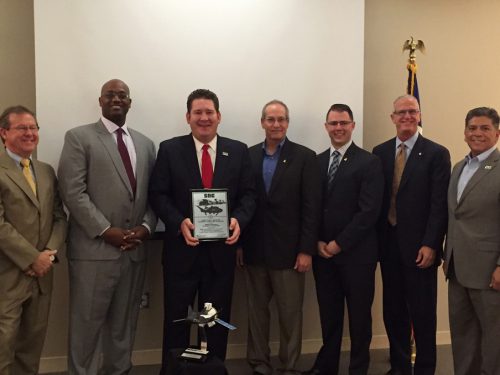
This week Sierra Nevada Corp. (SNC) announced that the Midland, Texas, International Air and Space Port has achieved the first step toward becoming an approved landing site for SNC’s Dream Chaser “space plane,” which is currently under development.
“Midland is already an FAA-licensed spaceport, making pursuit of Dream Chaser landing opportunities a logical next step,” said John Roth, vice president of Business Development and Strategy for SNC’s Space Systems. “We entered into an agreement to begin working on the Landing Site Designation earlier this year and are pleased to have successfully progressed in the process. Midland is now considered a compatible landing site for Dream Chaser commercial missions.”

SNC has been looking into landing at commercial airports for some time, having launched their “Dream Chaser-Preferred Landing Site Program” to work with spaceports and commercial airports to become designated landing sites for Dream Chaser.
“SNC developed the Landing Site Designation process to provide airports and spaceports around the world the opportunity to assess the feasibility of landing its Dream Chaser spacecraft on site,” says SNC. “The SNC Landing Site Designation is the first of several steps required in order to become an FAA licensed landing site.”
Dream Chaser, which can fly with or without crew, does not require hazardous chemicals for its operation, and therefore can land at any suitable runway at least 8,000 feet long, anywhere around the world, without requiring specialized equipment. With a propulsion system fueled by Nitrous Oxide and propane this also means immediate access to the spacecraft after landing, with only 10-20 minutes needed to exit the runway and keep conflicts with other aircraft using the same area to a minimum. For a nominal (planned) landing this might not mean much, but in an emergency abort (unplanned) scenario such quick access to Dream Chaser would allow other airport operations to proceed with minimal or no impact from the spacecraft’s unexpected arrival.
“Today’s announcement demonstrates Midland Spaceport’s continued commitment to furthering the commercial space industry on behalf of the City of Midland. Our goal is to one day see the Dream Chaser spacecraft land safely on our Midland International Air & Space Port runway,” said J. Ross Lacy, president of the Spaceport Development Board.
It’s important to note again that these would be for commercial missions, not NASA missions supporting ISS resupply flights. Those would be dedicated to landing at NASA’s Kennedy Space Center in Florida, utilizing KSC’s former space shuttle runway (SLF). All Dream Chasers, whether commercial or otherwise, would use KSC facilities for vehicle processing.
SNC’s Dream Chaser was not selected by NASA for big commercial crew contracts, but was awarded a Commercial Resupply Services (CRS) contract (CRS-2) in January 2016 to resupply the ISS from 2019 through 2024 (along with SpaceX and Orbital ATK).
That said, the vehicle is small enough that it can be loaded on a small cargo plane to return to KSC, in the event it lands someplace besides the SLF, which future commercial missions may in fact require if the customer is located elsewhere in the country and wants their payload(s) ASAP. Missions and clients will determine other landing sites in the future.
In the time since losing the crew contract SNC has been relatively quiet about Dream Chaser development, but they have been busy ever since continuing to upgrade their flight test article, developing a second flight test series for it, speaking with other government space agencies and private companies to find a market for Dream Chaser without NASA funding (read our 1-on-1 interview with SNC regarding an international Dream Chaser HERE), and building the structure of their first operational orbital vehicle (thanks to Lockheed Martin).
.
Be sure to “Like” AmericaSpace on Facebook and follow us on Twitter: @AmericaSpace
.






A fundamental mistake with the shuttle was combining cargo and crew functions on a single craft. In hindsight it was simply a horrible choice. If they had decided to put the crew in something like this- with an escape tower attached to it- history would be very different.
There was never any real justification for the cargo bay of dreams. Bringing stuff back down is not the point and trying to go there for no good reason pretty much sunk the whole shuttle program.
Dream Chaser bears some resemblance to the Soviet “Bor” test vehicle, the forerunner to the Buran shuttle.
For good reason. NASA’s HL-20 design was based on captured data from the Soviet Bor-4. The HL-20 went through all the design work and a full-scale mock-up was built, but the project never went any further. The Dream Chaser’s design is based on the HL-20.
“After the acquisition of Orbitec LLC in July 2014, Sierra Nevada Corporation announced a major change to the propulsion system. The hybrid rocket engine design was dropped, in favor of a cluster of Orbitec’s Vortex engines. The new engines would use propane and nitrous oxide as propellants.”
From:’Dream Chaser’ Wikipedia
At: https://en.wikipedia.org/wiki/Dream_Chaser
See also:
‘NITROUS OXIDE / HYDROCARBON FUEL ADVANCED CHEMICAL PROPULSION: DARPA
CONTRACT OVERVIEW’ By Roger Herdy Qualis Corporation Huntsville, Alabama
At: https://tfaws.nasa.gov/TFAWS06/Proceedings/Aerothermal-Propulsion/Papers/TFAWS06-1026_Paper_Herdy.pdf